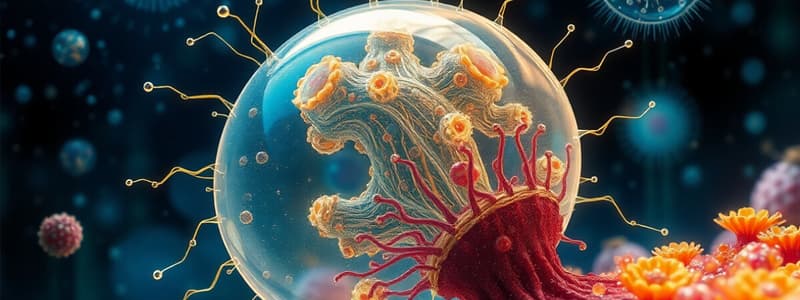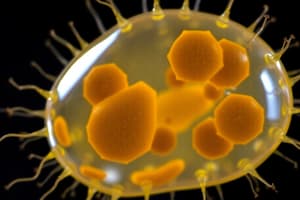Podcast
Questions and Answers
What is the primary function of the contractile vacuoles in protozoa?
What is the primary function of the contractile vacuoles in protozoa?
- Produce pseudopodia
- Regulate osmotic pressure (correct)
- Assist in food digestion
- Aid in locomotion
Which of the following structures is responsible for the locomotion of protozoa?
Which of the following structures is responsible for the locomotion of protozoa?
- Food vacuoles
- Endoplasmic reticulum
- Pseudopodia, cilia, or flagella (correct)
- Nucleus
How do protozoa typically ingest solid material?
How do protozoa typically ingest solid material?
- Via pseudopodia or cytostome (correct)
- Through contractile vacuoles
- Through diffusion
- By osmosis
What type of reproduction involves the fusion of a macrogamete and a microgamete in protozoa?
What type of reproduction involves the fusion of a macrogamete and a microgamete in protozoa?
Which layer of the protozoan cytoplasm is primarily involved in respiration and discharging waste material?
Which layer of the protozoan cytoplasm is primarily involved in respiration and discharging waste material?
What occurs during multiple fission in protozoa?
What occurs during multiple fission in protozoa?
What is the role of chromatin granules found in the nucleus of a protozoan?
What is the role of chromatin granules found in the nucleus of a protozoan?
What type of cell division is characterized by one cell dividing into two identical daughter cells?
What type of cell division is characterized by one cell dividing into two identical daughter cells?
Which function is not performed by the cytoplasm of a protozoan?
Which function is not performed by the cytoplasm of a protozoan?
What occurs during binary fission in unicellular protozoan organisms?
What occurs during binary fission in unicellular protozoan organisms?
Which of the following is a key characteristic of trophozoite stage in protozoa?
Which of the following is a key characteristic of trophozoite stage in protozoa?
What is the function of the Golgi bodies within a protozoan cell?
What is the function of the Golgi bodies within a protozoan cell?
How do protozoa typically regulate osmotic pressure?
How do protozoa typically regulate osmotic pressure?
Which component of the protozoan nucleus is primarily responsible for the synthesis of ribosomes?
Which component of the protozoan nucleus is primarily responsible for the synthesis of ribosomes?
What primarily triggers the formation of food vacuoles in protozoa?
What primarily triggers the formation of food vacuoles in protozoa?
Which statement about the reproduction in protozoa is false?
Which statement about the reproduction in protozoa is false?
Which of the following best describes the function of pseudopodia in protozoa?
Which of the following best describes the function of pseudopodia in protozoa?
What event characterizes asexual reproduction by multiple fission in protozoa?
What event characterizes asexual reproduction by multiple fission in protozoa?
Which structure within a protozoan cell is primarily involved in the regulation of cell functions?
Which structure within a protozoan cell is primarily involved in the regulation of cell functions?
In which process do protozoa expel undigested materials?
In which process do protozoa expel undigested materials?
What is the primary role of the contractile vacuoles in protozoa?
What is the primary role of the contractile vacuoles in protozoa?
What is a key feature of the trophozoite stage in protozoa?
What is a key feature of the trophozoite stage in protozoa?
Which layer of a protozoan's cytoplasm is described as the outer hyaline layer?
Which layer of a protozoan's cytoplasm is described as the outer hyaline layer?
Which type of food ingestion involves solid materials through pseudopodia?
Which type of food ingestion involves solid materials through pseudopodia?
Flashcards
Protozoa
Protozoa
Single-celled eukaryotic microorganisms belonging to Kingdom Protista.
Trophozoite
Trophozoite
The active, feeding stage of a protozoan.
Cytoplasm
Cytoplasm
The jelly-like substance inside a protozoan cell, containing organelles.
Contractile Vacuoles
Contractile Vacuoles
Signup and view all the flashcards
Nucleus
Nucleus
Signup and view all the flashcards
Simple Binary Fission
Simple Binary Fission
Signup and view all the flashcards
Multiple Fission (Schizogony)
Multiple Fission (Schizogony)
Signup and view all the flashcards
Sexual Reproduction in Protozoa
Sexual Reproduction in Protozoa
Signup and view all the flashcards
What are Protozoa?
What are Protozoa?
Signup and view all the flashcards
What are the functions of the cytoplasm in Protozoa?
What are the functions of the cytoplasm in Protozoa?
Signup and view all the flashcards
What is the role of the contractile vacuole?
What is the role of the contractile vacuole?
Signup and view all the flashcards
What does the nucleus of a Protozoan control?
What does the nucleus of a Protozoan control?
Signup and view all the flashcards
How do Protozoa obtain oxygen?
How do Protozoa obtain oxygen?
Signup and view all the flashcards
How do Protozoa feed?
How do Protozoa feed?
Signup and view all the flashcards
How do Protozoa eliminate waste?
How do Protozoa eliminate waste?
Signup and view all the flashcards
What are the methods of asexual reproduction in Protozoa?
What are the methods of asexual reproduction in Protozoa?
Signup and view all the flashcards
What are the key features of a Protozoan cell?
What are the key features of a Protozoan cell?
Signup and view all the flashcards
What is the role of the cytoplasm in Protozoa?
What is the role of the cytoplasm in Protozoa?
Signup and view all the flashcards
What is the function of the contractile vacuole?
What is the function of the contractile vacuole?
Signup and view all the flashcards
Study Notes
Protozoology
- Protozoa are unicellular eukaryotic organisms that can exist singly or in colonies.
- They belong to the Kingdom Protista.
- The single protozoan cell performs all necessary functions.
Morphology of Protozoa
- Trilaminar unit membrane: Forms the boundary of the protozoan cell.
- Cytoplasm: Comprises two layers:
- Ectoplasm: The outer, hyaline layer, involved in locomotion, engulfing food (forming pseudopodia), respiration, waste removal, and providing protection.
- Endoplasm: The inner granular layer, containing various structures like food vacuoles, Golgi bodies, contractile vacuoles, and endoplasmic reticulum. Contractile vacuoles help regulate osmotic pressure.
Nucleus
- The nucleus is the most crucial structure, regulating essential functions like reproduction and other vital processes.
- Nuclear membrane: Encloses the nucleus.
- Nuclear sap (nucleoplasm): The fluid within the nucleus.
- Chromatin granules: Contain the genetic material (DNA).
- Karyosome (nucleolus): A distinct DNA-containing body situated centrally or peripherally within the nucleus.
Biology of Protozoa
- Movement: Some protozoa move by pseudopodia, cilia, or flagella, while others do not move.
- Respiration: Protozoa may directly take in oxygen or use oxygen released from metabolic processes.
- Nutrition: Protozoa obtain nutrition by absorbing liquid food or ingesting solid material. Solid material is enveloped within pseudopodia or cytostome and becomes contained in food vacuoles. Digestive enzymes then process the food, and the waste is expelled either through the outer surface or via a special opening (cytopyge).
- Excretion: Protozoa excrete waste materials through osmotic pressure, contractile vacuoles, diffusion, or cytopyge.
Reproduction
- Protozoa reproduce asexually (simple binary fission, multiple fission – schizogony) or sexually (syngamy, fusion of two cells, one female (macrogamete) and one male (microgamete)).
- Simple binary fission: Individuals split into two organisms through longitudinal or transverse division.
- Multiple fission (schizogony): The nucleus undergoes multiple divisions preceding cytoplasmic division. This creates many smaller merozoites (or sporozoites) within the schizont. A good example of this is Plasmodium.
- Sexual reproduction (syngamy): Involves the fusion of two cells (one female and one male), which leads to microgametes and macrogametes (gametocytes, in some cases).
Classification of Protozoa
- Protozoa are categorized based on their movement methods (flagella, pseudopodia, cilia, or no movement), and often categorized as flagellates, sarcodina, sporozoa, or ciliates. Specific examples like Trypanosoma, Leishmania, Giardia, Trichomonas, Entamoeba, Plasmodium, Balantidium coli, etc. are classified within these groups, based on their movement and characteristics.
Life Cycle of Protozoa
- Simple life cycle: Protozoa with intestinal and luminal/urogenital life cycles often require just one host and reproduce asexually within that host. Transmission is normally direct.
- Complex life cycle: Most blood and tissue parasites pass between a vertebrate and an invertebrate host, thus undergoing an alternation of generations. Transmission is generally indirect. A good example presented is the comparison of Trichomonas and Malaria life cycles, highlighting the variations in transmission.
Questions
- Question 1: Protozoa belong to the kingdom Protista.
- Question 2: The protozoa that use pseudopodia for movement are Entamoeba.
Studying That Suits You
Use AI to generate personalized quizzes and flashcards to suit your learning preferences.





